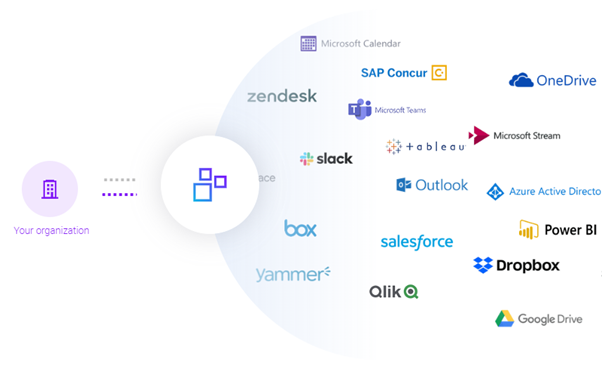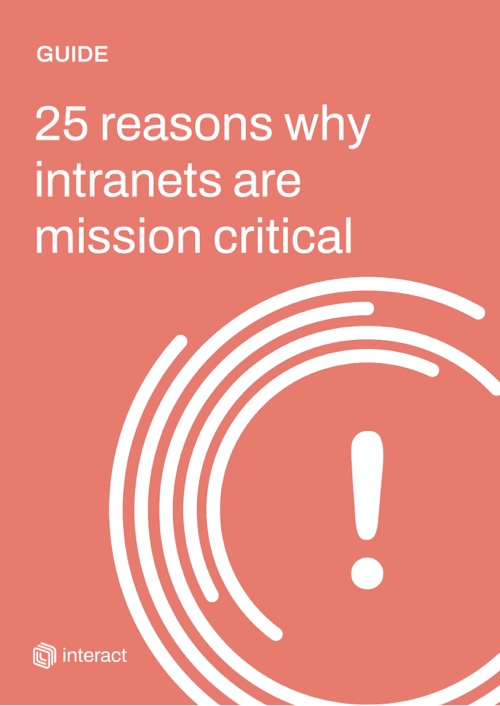Give your workforce a boost with these user-friendly employee portal examples. Discover the important UI/UX elements to consider and learn how to populate your intranet with engaging content.
Is your digital workplace a joy to navigate? Is it just as easy for a frontline worker to access content as a colleague operating from a home office?
Whether they’re viewing payslips, accessing a CRM, or reading blogs, employees don’t want to waste time repeatedly searching and logging in to multiple platforms. Typically, they want a single employee portal that acts as a doorway to the entire organization.
The most effective way to achieve this is through thoughtful planning and design of the systems they frequently use.
Just like your corporate website, your intranet design and content should help staff to find what they need quickly and easily. That’s why we’re sharing some of our favorite employee portal examples to inspire you as you create your own modern intranet.
What is an employee portal?
Your workplace already has several employee portal examples within it then because you may use separate platforms for HR and learning and development (L&D), for example. All of these are employee portals because they give staff access to secure online environments and help them perform tasks or access information.
Employee portals typically enable users to:
- Access payroll and benefits information
- Create leave requests
- Check company policies and procedures
- Participate in L&D courses
- Use communication and collaboration tools
In addition to providing access to resources, employee portals also streamline tasks and reduce the workload of IT and HR.
However, employee portals that simply enable task completion can feel sterile and do little to improve company culture.
Fortunately, there is another kind of employee portal that brings them together and uses design to make them engaging and user-focused. This is your company intranet.
23 ways your workplace can use a mission-critical intranet to achieve its objectives
Intranets are employee portals for culture and communication
An intranet is similar to other employee portals in that it is also a private enterprise network that supports employees to perform their roles.
Crucially, however, an intranet does not just enable users to perform single tasks. It gives them access to communications, content, colleagues, and the wider digital workplace.
How is an intranet different from other employee portal examples?
- An intranet can be customized and branded to reflect the distinct look and culture of an organization.

- An intranet is a front-door experience to all employee portals. The intranet homepage should direct users to all the other platforms in your digital workplace.
- It offers a highly personalized user experience based on employee criteria. Individuals in different countries or roles can see different content and have access to different processes. Rather than the one-size-fits-all approach of many platforms, a personalized intranet is designed to foster greater engagement.

What your employee portal should include
The exact makeup of your intranet or employee portal will depend on your organization, workforce needs, and industry.
Generally, however, a self-service portal that can meet a wide range of needs will either offer the following features natively, or will signpost the way to another platform that does.
Your front page should include some or all of these:
1. People directory
A powerful part of your intranet, your people directory will automatically sync with providers such as Azure Active Directory for the most up-to-date information on colleagues.
2. Enterprise search
Employees should be able to easily search through content and company policies. Having features such as “Best Bets” can help to show recommendations that resolve queries quickly.
3. HR platforms
Whether it’s to book vacations or check shift patterns, staff will want easy access to HR software.
4. Finance
Claiming expenses or checking payslips is another common task staff want to accomplish without sending emails. Intranet integrations with financial software can be helpful.
5. Employee handbook
The content in your employee handbook isn’t just useful for new hires during onboarding. People will frequently want to revisit information about benefits and policies, so make sure this content is either held on regularly updated pages or uploaded in the form of downloadable resources (e.g., PDFs).
23 ways your workplace can use a mission-critical intranet to achieve its objectives
6. IT tickets
Give employees a place to submit and track helpdesk requests. Adding a platform such as Zendesk to your intranet menu enables users to log and view tickets. They can also access FAQs, IT policies, and important updates.
7. Personalized media feed
Keeps everyone updated on successes and developments and allows individuals to share what they’re working on with the rest of the organization.
8. Events calendar
When is your next all-hands meeting? Does the UK office have a public holiday this week? It‘s important to have relevant dates visible to all.
9. Values
If your company values are buried away in documents no one reads then they’re unlikely to inspire action. Boost corporate culture and employee engagement by broadcasting values and examples of values-focused behavior on the front page of your employee portal.
10. Employee recognition
Another area of workplace life that can benefit from publicity is employee recognition. There are lots of ways that managers can give praise personally, but allowing colleagues to award points and mention each other on your intranet is a great way to inspire action and highlight good work.

Designing an employee portal for your industry
By now you already know what you want your employee portal to achieve, and you’ve got plenty of content, so what should it look like?
Again, this will depend on your company and your workforce, but the following intranet design examples give some insights into what you should consider when creating a digital workplace for your organization.
Intranet design for financial businesses

Financial businesses face numerous challenges that arise from operating in highly regulated, internationally focused environments.
First, given the nature of the sector, staff may expect the intranet to be a knowledge base or internal publisher of fast-moving company news, expert insight on changing markets, and updates about strategy and leadership.
Every financial company has subject-matter experts in different areas of tax, policy, or investments; your intranet homepage is the place to let them share their expertise.
Also, when a new economic crisis or opportunity arises, employees will require a single place to go to understand what it means for the company, for them, and for clients.
Secondly, with few or no frontline staff, the design focus of a financial services intranet may lean less towards transactional integrations and more to news and events.
The financial intranet homepage above delivers a news-centric page that shows off the company’s experts. This design features a single headline story promoted above the fold and then a secondary level that presents a split focus on recent news and leadership comms.
Events are also prominently presented to give insights into key upcoming activities. The left-hand menu enhances productivity by providing links to frequently used tools and resources. As this page serves multiple purposes, the layout has been made clean and simple to reduce cognitive load.
Information and compliance are extremely important within financial services, so a Resource Library is prominent in the top menu bar. Mandatory Read functionality should also be used to track when users have read and acknowledged key content.
The design of a healthcare intranet homepage

The workplace settings and objectives of healthcare professionals are significantly different to finance, and your employee portal design should also reflect this.
Typically, staff will be in a wider variety of locations, including hospitals, care settings, and in the community. They will likely have less time to spend checking news and a greater need to access key information quickly.
This homepage for a healthcare organization prioritizes helping employees find what they need by placing the search bar at the top of the page. Whereas the search on the finance homepage was subtle, it stands out here and immediately draws the eye. Even the UX writing is subtly different, with the bold “How can we help you?” title immediately driving attention and action.
The limited time that healthcare professionals have to spend on the intranet is also reflected in the prominent use of Quick Links buttons. This bar of large action buttons helps to direct people to the content and subject matter areas they need, with high consideration of UX.
23 ways your workplace can use a mission-critical intranet to achieve its objectives
Collaboration is also important in healthcare, and professionals frequently need to know what their colleagues and peers are working on.
Whether it’s best practices in care for the elderly or a recent update on surgical procedures, this employee portal design prioritizes relevant discussions by blending suggested content based on user preferences with content that coworkers are interfacing with.
The relevancy of content and discussions displayed on this homepage is refined further by filtering based on the user’s historical interactions on the page.
A retail employee homepage that reflects sector-specific needs

Like healthcare, retailers must communicate with dispersed workforces.
People from corporate HQ may have little understanding of what happens in an individual store while those working locally are unlikely to visit head office. They may not even go to stores outside of their immediate area.
Offering people content that speaks to their specific experience is important then, but so too is unifying people under a single brand.
A retail intranet homepage should use design to do some of the heavy lifting here.
This homepage for a retail organization does this by balancing a mix of global and local content. It presents users with large story panels that reflect their locations and roles, but also ties communications back to the company through the global news panel in the center.
As a customer-centric industry with a younger than average worker demographic (31% of workers in clothing are under 24), retail companies may also place greater emphasis on social media and advocacy.
The placement of a recognizable social-style feed and clear signposting through social media widgets helps to make the intranet more user friendly and engaging for that audience.
Don’t forget to pick a name for your intranet that reflects your internal brand. Discover our expert tips for naming your intranet.
Give employees the consumer-grade tools they expect
There are so many free digital experiences that do an amazing job of UI and UX that most of us now expect a high-grade product as standard.
Whether we’re making and editing videos on a social media platform or creating art with AI, we set the bar high. Employee portals should offer an experience that’s comparable to the websites and mobile apps we all use every day.
Although the first iterations of intranets during the 1990s often fell into disuse because they were poorly designed document lists, times have changed.
A combination of design and strategy can help you to create an employee portal that presents resources in an intuitive, engaging way, and keeps visitors coming back for more.


